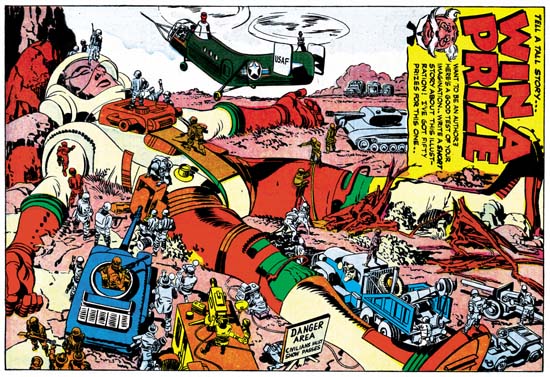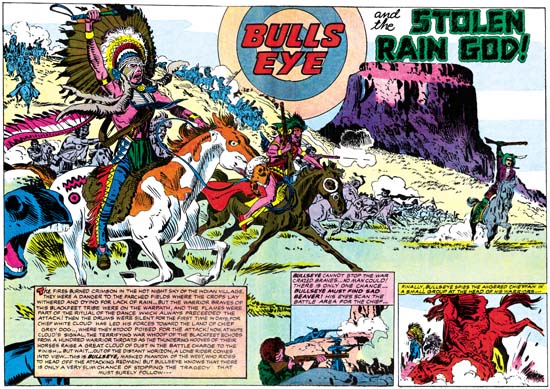
Win A Prize #1 (February 1955) pinup, art by Jack Kirby
Enlarged view
Pinups, both single and double paged, played an important part of Boys’ Ranch (October 1950 to August 1951) but they did not appear at all in Black Magic which also started in October 1950. Nor did they appear in either Strange World of Your Dreams (August 1952 to March 1953) or Fighting American (April 1954 to April 1955). Pinups did play a marginal roll in some other titles. A single page pinup, “Desk Sergeant”, appeared in Police Trap #2 (November 1954) and a double page spread was used in Bullseye (discussed below). There is also the pinup from Win A Prize #1. While printed on a single page, its horizontal format leaves little doubt that originally the Win A Prize splash was meant to be a double page centerfold. Joe Simon has said that initially this pinup was to have been used in Captain America #11 but Joe and Jack’s sudden exit meant that issue was done by other artists. If Joe’s story is true, this pinup underwent modification before it was finally used. Of course Captain America would have had to have been removed. Sikorsky was just beginning their efforts in building helicopters while Simon and Kirby were working on Captain America and helicopters would not play a significant part in the military until after World War II. The helicopter in this pinup has a USAF marking, but the Air Force was not an independent military unit until after the war. At the bottom center of the splash is what looks very much like a television camera crew. While televisions were created before the war they did not really come into use until the late’40s.
The pinup’s theme of a modern day Gulliver is an interesting twist, particularly in using a futuristic spaceman as the giant. There are a score of little soldiers and civilians scattered about each involved in the individual tasks. The image presents a number of questions. Since no nearby rocket or flying saucer is shown, where did the spaceman come from? Although lying prone with eyes closed, the spaceman appears uninjured. With all the tanks and guns aimed at him the suggestion is that he still is alive. If that is so why are all the soldiers crawling over the spaceman even though he is not tied down or restrained in any way? There does not appear to be much in the way of ropes or cable, so what is the soldiers’ intention? Of course such unanswered question was the whole point as Uncle Giveaway is offering prizes for short stories based on this pinup. I wonder if it is too late to enter?

Bullseye #7 (August 1955) “The Stolen Rain God”, art by Jack Kirby
Enlarged view
During the final period of the Simon and Kirby studio, the only double page splash to actually get printed as such appeared in Bullseye. Oddly it was in the final issue published by Charlton. It is hard to believe that Joe and Jack thought this splash would help save the title. Having Charlton’s print the former Mainline comics looks more an attempt to get some money for art that Joe and Jack could no longer afford to publish themselves due to problems with their distributor. Charlton was notorious for their low pay so I am sure they did not offer much to Simon and Kirby, but it was better then nothing. If by some miracle they sold well enough to warrant continuation, so much the better. But for the most part Charlton used up the final art and cancelled the titles. Foxhole was extended for a single issue produced by Charlton artists with Joe and Jack probably having nothing to do with it. The postal permit for In Love was transferred to Charlton’s new romance title I Love You, which, although having a Kirby drawn cover for its initial issue, was again filled with story art probably created by Charlton artists. I suspect that careful investigation of other Charlton comics will reveal the transfer of the postal permit from the other former Mainline titles Police Trap and Bullseye as well. The only Simon and Kirby title that Charlton ran with for a few issues was not a Mainline title at all. It was Charlie Chan, a title previously licensed to Prize some years before. It was more of a Joe Simon production with Jack Kirby only providing the cover art for the first Charlton issue (#6 June 1955). Joe would help put it together for Charlton until it too was cancelled with issue #9 (December 1955). So I believe the wide splash in Bullseye #7 came too late to be considered a serious attempt to bolster sales of the Bullseye title. I cannot help but wonder if when the breakup of the Simon and Kirby studio was clearly possible, if it had not happened already, whether the presence of this splash was brought on by a nostalgic memory of Simon and Kirby’s use of the centerfold splash in their first big hit, Captain America.
Jack has drawn a good splash. It is just that after so many marvelous double page spreads in the past it is hard for me to get too enthusiastic about this one. It is a well balanced composition with the prominent Indian chief on our left offset by the plateau and title on the right. The chief certainly presents an impressive figure what with his large headdress (could that really be expected to stay on during the charge?) and ornate apparel. The horse cut off on our left showing only a mouth and knee makes the viewer really feel that he is at the head of the line of charging warriors. The colorist wisely blocked out the smaller figures in simple colors otherwise the foreground figures would have been lost among a patchwork of colors. This allowed the small figure of Bullseye on our right to still stand out. The most unusually aspect of this splash, unique among Simon and Kirby wide angle screams, was that it is actually an oversize story panel. We find Bullseye racing in front of the attacking Indians as he tries to prevent the unfolding tragedy that the war will certainly bring. It is a very risking thing for Bullseye to do since his racing across Indian line could easily make him the victim of friendly fire. The two smaller panels on the bottom provide an explanation on Bullseye’s objective.
The splash for “The Stolen Rain God” was the last double page art for a Simon and Kirby production. Even though the studio and their partnership was over, Kirby always seemed willing to give Simon a hand whenever Joe tried to launch new comics. One such effort included the wide angle screams that will be the subject of the next chapter of my serial post.

